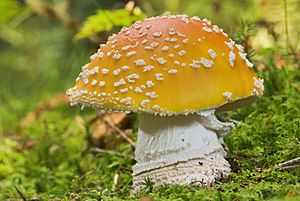Agaricomycetes facts for kids
Quick facts for kids Agaricomycetes |
|
|---|---|
 |
|
| Amanita muscaria (Agaricales) | |
| Scientific classification |
|
| Kingdom: | Fungi |
| Division: | Basidiomycota |
| Subdivisio: | Agaricomycotina |
| Class: | Agaricomycetes Doweld (2001) |
| Subclasses/Orders | |
|
Agaricomycetidae
Phallomycetidae
incertae sedis (no subclass)
|
|
Agaricomycetes is a large group of fungi. It is a class of fungi that includes many different kinds of mushrooms and other fungi. There are over 20,000 known types (species) in this group. They are found all over the world.
What Are Agaricomycetes?
Agaricomycetes are special because they all produce something called a basidiocarp. This is the part of the fungus that we usually see. It's like the "fruit" of the fungus. These basidiocarps can be very tiny. Some are just a few millimeters wide. Others can be huge!
Amazing Sizes
Some Agaricomycetes can grow to incredible sizes. For example, there's a giant polypore fungus called Fomitiporia ellipsoidea. Its basidiocarp can be several meters across. It can even weigh up to 500 kilograms (about 1,100 pounds)!
But the biggest part of some fungi is often hidden. The main body of a fungus is called its mycelium. This is a network of tiny threads that usually grows underground or inside wood. One of the largest and oldest living things on Earth is an Agaricomycetes fungus. It's called Armillaria gallica. Its mycelium can spread over 150,000 square meters. That's like 37 football fields! This huge underground network can weigh 10,000 kg. Scientists think it can live for 1,500 years or more.
Where Do They Live?
Most Agaricomycetes live on land. Only a few types live in water. They play a very important role in nature. Many of them are "decayers." This means they break down dead plants and trees. They are especially good at breaking down wood. This process helps recycle nutrients back into the soil.
Different Ways of Life
While many Agaricomycetes are helpful decayers, some have different lifestyles:
- Pathogenic or Parasitic: Some species can cause diseases in plants. They might live on other living things and get their food from them.
- Symbiotic: Other Agaricomycetes live in a helpful partnership with plants. A great example is mycorrhiza. These fungi grow around or into the roots of forest trees. They help the trees get water and nutrients from the soil. In return, the trees provide the fungi with sugars they make through photosynthesis. This partnership is very important for healthy forests.
See Also
 In Spanish: Agaricomycetes para niños
In Spanish: Agaricomycetes para niños

